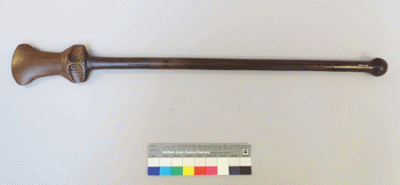 |
| Club 1886.1.1466 |
This club is from Vanuatu, from the island of Malakula, which Cook visited at the end of July 1774. It
is number 142 in the 'Catalogue of Curiosities', and is one of only
three items collected in 'Mallicollo', the others being a bow and a
bundle of poisoned arrows. Meetings with the inhabitants of Malakula only occurred on the beaches - the visitors were not permitted to venture inland. As a result the objects collected here are the kinds of things that would have been carried on the person.
George Forster writes in 'A Voyage Round the World' that
'Besides bows and arrows they wore a club of the casuarina-wood, which
hung from their right shoulder , from a thick rope, made of a kind of
grass. This club was commonly knobbed at one end, and very well polished, like all their manufactures. It did not exceed two feet and a half in length, and appeared to be reserved for close engagement, after emptying the quiver.' The
inhabitants of the island were persuaded to sell their arms for 'a
handkerchief, or a piece of Taheitee cloth, or English frieze' (a type of
coarse cloth). As they
departed Malakula, Forster said that that 'the natives came to us with
all their fourteen canoes, and sold us great numbers of arrows of all
kinds and some clubs….they seemed very eager to part with their arms for
Taheitee cloth.'
 |
| Club head |
The club in the Pitt Rivers collection is Janus-headed,
having two faces with highly conventionalised features. Lissant Bolton,
in her chapter entitled 'Place, Warfare and Trade 1700-1840' in 'Art in Oceania: A New History' (Peter Brunt et al. London: Thames and Hudson,
2012) writes that 'part of the Forster Collection now in the Pitt Rivers Museum,
Oxford, is a club collected at Port Sandwich, Malakula Vanuatu, in July
1774. Kirk Huffman identifies it as a "rare type of high-status club"
that signifies links between south-east Malakula and west Ambrym, north
Ambrym and south Pentecost. Although the club was very likely made where
it was collected, it appears that this, one of the first objects ever
collected by Europeans in island Melanesia, was an item in a ritual
network that linked a number of adjacent islands and regions. This kind
of club could be used as a weapon, but also in ceremonies and as a dance
club. It was above all an object that related to a complex system of
status enhancement: it would have been owned by a high-ranking man, and
would have signified his status as a someone to be treated with
respect.'